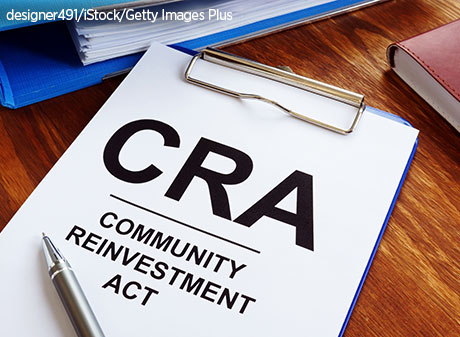Fed Releases Proposal for CRA Reform, Seeks Comments

This post is part of a series titled “Supervising Our Nation’s Financial Institutions.”
The Community Reinvestment Act (CRA) is a federal law that requires federally insured banks to meet the credit needs of people in their communities while meeting safety and soundness standards. At the time of its 1977 passage, lawmakers were concerned about unequal access to credit and policies such as redlining, especially in low-and moderate-income communities. Bank regulators were given the task of writing, implementing and enforcing regulations to ensure banks were meeting the goals of the law.
CRA regulations were last updated in 1995, and much has changed in the banking industry in the last 25 years. Technological change—especially the move to online and mobile banking—means that a CRA focused solely on activity in brick-and-mortar branches will miss a large swath of banking activity as an increasing number of banks begin to operate online.
Reform Begins
In 2015, bank regulators began seeking feedback from various stakeholders—community development organizations, civil rights groups, bankers and other regulators—for ideas to improve and modernize the CRA. Respondents indicated they wanted:
- A reconsideration of the definition and use of assessment areasEvery bank subject to the CRA has a defined assessment area. A bank’s assessment area is the geographic area that can reasonably be served by each of a bank's locations, including its main office, branches and deposit-taking ATMs.
- More incentives for banks to serve targeted communities
- A lighter reporting and recordkeeping burden
- Clarification of performance measures and thresholds
- A refinement of CRA ratings methodology.For more information, see the report “Joint Report to Congress: Economic Growth and Regulatory Paperwork Reduction Act (PDF),” jointly compiled by the Board of Governors of the Federal Reserve System, the Office of the Comptroller of the Currency, the Federal Deposit Insurance Corporation and the National Credit Union Administration.
Armed with this information, the three federal banking regulators—the Federal Deposit Insurance Corporation (FDIC), the Federal Reserve and the Office of the Comptroller of the Currency (OCC)—began work on a consensus proposal to update CRA regulations and examination procedures.
Consensus has proved difficult, however, and the agencies have yet to converge on a unified proposal. The OCC has finalized its own rule that will not be fully in effect until 2023.For more information, see the OCC’s press release “OCC Finalizes Rule to Strengthen and Modernize Community Reinvestment Act Regulations.” The FDIC initially signed on to the OCC’s proposal, but it has since withdrawn. In September, the Fed released an Advance Notice of Proposed Rulemaking (ANPR) on the CRA that outlines the general contours of reform based on input it has received to date.For more information, see the Fed’s webpage covering CRA proposed rulemaking.
The Fed’s Approach
The Fed is now seeking comments from the public on its proposal to modernize the CRA by “strengthening, clarifying, and tailoring the CRA regulations to reflect the current banking landscape and better meet the core purpose of the CRA.”For more information, see the Fed’s fact sheet on the CRA (PDF). The Fed’s proposal seeks to:
- Ensure that a wide array of banking needs are being met
- Promote financial inclusion
- Address changes to the banking industry
Although the two proposals share similarities—such as modernizing assessment areas beyond an institution’s traditional bank network and providing banks a list of acceptable activities that will receive CRA credit—there are important differences.
One of the primary ways the Fed’s proposal differs from the OCC’s rule is that the Fed proposes to use information and data already collected from its larger supervised institutions in assessing them for CRA compliance. Smaller banks will be exempted from most of these requirements. The OCC, conversely, will require new data from all banks to measure compliance with its rule.
Another difference is that the Fed’s proposal keeps separate tests and subtests for retail and community development activities within each assessment area of a bank. Under this proposal, large banks will be assessed on retail lending, retail services, community development financing and community development services in each of its assessment areas. Smaller banks will not be evaluated on their retail services or community development activity. Instead, they will be evaluated using existing methodology.
Evaluating these activities separately in each assessment area allows for tailoring of CRA metrics to a bank’s local market conditions. The OCC, on the other hand, will evaluate banks on a metric that combines retail lending and community development across assessment areas after it is determined that performance is satisfactory in a certain number of assessment areas. The score banks will receive will be largely based on the dollar value of CRA-eligible projects. Critics of the OCC plan are concerned that smaller-dollar loans, investments and services will be undervalued in smaller markets.
Next Steps
The Fed’s ANPR is open for public comment until Feb. 16. In addition to addressing the nuts and bolts of a CRA rule, the Fed is asking for suggestions on how to create incentives for banks to invest in:
- Minority depository institutions
- Women-owned financial institutions
- Low-income credit unions
- Community development financial institutions
- Underserved communities outside of banks’ traditional assessment areas, like Native American communities
Fed and OCC officials have expressed hope that the two proposals can be meshed into one consistent rule that will apply to all banks, regardless of charter. Stakeholders too want a unified rule to avoid confusion and possible unintended consequences. With slightly more than two years until the OCC’s rule goes into effect, there is a significant window to make a joint rulemaking a reality.
Notes and References
- Every bank subject to the CRA has a defined assessment area. A bank’s assessment area is the geographic area that can reasonably be served by each of a bank's locations, including its main office, branches and deposit-taking ATMs.
- For more information, see the report “Joint Report to Congress: Economic Growth and Regulatory Paperwork Reduction Act (PDF),” jointly compiled by the Board of Governors of the Federal Reserve System, the Office of the Comptroller of the Currency, the Federal Deposit Insurance Corporation and the National Credit Union Administration.
- For more information, see the OCC’s press release “OCC Finalizes Rule to Strengthen and Modernize Community Reinvestment Act Regulations.”
- For more information, see the Fed’s webpage covering CRA proposed rulemaking.
- For more information, see the Fed’s fact sheet on the CRA (PDF).
Additional Resources
- On the Economy: Small Business Lending Gives a Boost to Banks
- On the Economy: Bank Supervision Adapts to Pandemic Challenges
- On the Economy: Clarity for Banks Serving the Hemp Industry
Citation
Carl White, ldquoFed Releases Proposal for CRA Reform, Seeks Comments,rdquo St. Louis Fed On the Economy, Oct. 28, 2020.
This blog offers commentary, analysis and data from our economists and experts. Views expressed are not necessarily those of the St. Louis Fed or Federal Reserve System.
Email Us
All other blog-related questions


